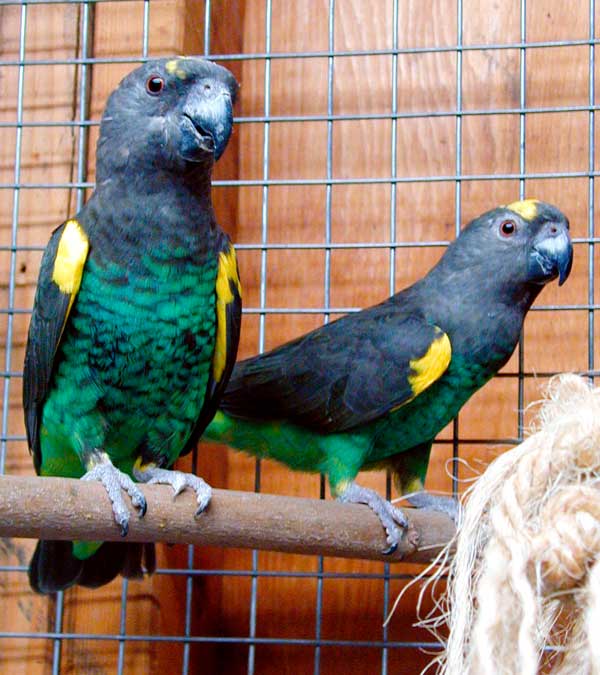
Poicephalus meyeri (*)
Superregnum: Eukaryota
Cladus: Unikonta
Cladus: Opisthokonta
Cladus: Holozoa
Regnum: Animalia
Subregnum: Eumetazoa
Cladus: Bilateria
Cladus: Nephrozoa
Superphylum: Deuterostomia
Phylum: Chordata
Subphylum: Vertebrata
Infraphylum: Gnathostomata
Megaclassis: Osteichthyes
Cladus: Sarcopterygii
Cladus: Rhipidistia
Cladus: Tetrapodomorpha
Cladus: Eotetrapodiformes
Cladus: Elpistostegalia
Superclassis: Tetrapoda
Cladus: Reptiliomorpha
Cladus: Amniota
Classis: Reptilia
Cladus: Eureptilia
Cladus: Romeriida
Subclassis: Diapsida
Cladus: Sauria
Infraclassis: Archosauromorpha
Cladus: Crurotarsi
Divisio: Archosauria
Cladus: Avemetatarsalia
Cladus: Ornithodira
Subtaxon: Dinosauromorpha
Cladus: Dinosauriformes
Cladus: Dracohors
Cladus: Dinosauria
Ordo: Saurischia
Cladus: Eusaurischia
Subordo: Theropoda
Cladus: Neotheropoda
Cladus: Averostra
Cladus: Tetanurae
Cladus: Avetheropoda
Cladus: Coelurosauria
Cladus: Tyrannoraptora
Cladus: Maniraptoromorpha
Cladus: Maniraptoriformes
Cladus: Maniraptora
Cladus: Pennaraptora
Cladus: Paraves
Cladus: Eumaniraptora
Cladus: Avialae
Infraclassis: Aves
Cladus: Euavialae
Cladus: Avebrevicauda
Cladus: Pygostylia
Cladus: Ornithothoraces
Cladus: Ornithuromorpha
Cladus: Carinatae
Parvclassis: Neornithes
Cohors: Neognathae
Cladus: Neoaves
Cladus: Telluraves
Cladus: Australaves
Ordo: Psittaciformes
Familia: Psittacidae
Subfamilia: Psittacinae
Tribus: Psittacini
Genus: Poicephalus
Species: Poicephalus meyeri
Name
Poicephalus meyeri (Cretzschmar, 1827)
References
Atlas zu der Reise im nördlichen Afrika p.18 BHL pl.11 BHL
IUCN: Poicephalus meyeri (Least Concern)
Vernacular names
Afrikaans: Bosveldpapegaai
čeština: Papoušek žlutotemenný
Deutsch: Goldbugpapagei
English: Meyer's Parrot
suomi: Afrikankaija
français: Perroquet de Meyer
magyar: Meyer aranyosvállú papagája
Nederlands: Meyers papegaai
norsk: Gulissepapegøye
русский: Мейеров длиннокрылый попугай
Meyer's parrot (Poicephalus meyeri), also known as the brown parrot,[2] is a species of parrot native to Africa. A Meyer's parrot has grey feathers, turquoise belly, blue rump, and bright yellow markings on the carpal joint of the wings. Most subspecies have some yellow on the top of the head as well. Forshaw (1989) recognizes six subspecies of P. meyeri which vary in home range, size and in markings, including the extent of yellow markings to the head and wings, and the intensity of turquoise markings on the belly and rump.
Taxonomy
German physician and ornithologist Philipp Jakob Cretzschmar described Meyer's parrot in 1827. The name commemorates the German ornithologist Bernhard Meyer.[3]
The six subspecies are:
P. m. meyeri (Cretzschmar, 1827) — s Chad to w Ethiopia
P. m. saturatus (Sharpe, 1901) — Uganda and w Kenya to w Tanzania
P. m. matschiei (Neumann, 1898) — c Tanzania, se Congo, Zambia and n Malawi
P. m. reichenowi (Neumann, 1898) — c Angola to s Congo
P. m. damarensis (Neumann, 1898) — n Namibia, s Angola and nw Botswana
P. m. transvaalensis (Neumann, 1899) — Botswana, Zimbabwe and n South Africa
Subspecies P. m. damarensis and P. m. reichenowi lack yellow markings on the head, while P. m. transvaalensis may have little to no yellow on the head. Belly and rump colours vary according to subspecies from turquoise to blue.
Distribution and habitat
Meyer's parrots are native to the plateau woodlands of sub-Saharan Africa where they occur in several woodland types including miombo, savanna woodlands, wooded grasslands and forests bordering watercourses or agricultural land. They are found in high densities in the Okavango Delta region of Botswana. They are also found in southern and central Africa (Chad, Sudan, South Sudan, Ethiopia, Congo, Angola, Tanzania, Zambia, Zimbabwe, Mozambique, and Namibia.
Behaviour
Food and feeding
Their wild diet includes fruit, seeds, nuts, berries and cultivated crops. Seeds of the various leguminous trees of the African woodlands are especially favoured, providing their staple food in some areas. Although they normally travel in pairs or small flocks, wild Meyer's parrots may gather in much larger numbers where food is plentiful. In drought years they wander in search of food.
Breeding
The Meyer's parrot nests in tree cavities. The eggs are white and there are usually three or four in a clutch. The female incubates the eggs for about 28 days and the chicks leave the nest about 60 days after hatching.[4]
Conservation status
Meyer's parrots are still common in the wild, although numbers have decreased locally following destruction of woodlands. It is generally not considered to be at risk,[1] as their large population, limited pressure from trade and hunting, and 6,000,000 km2 home range make these birds unlikely to face extinction in the near future. Trade in Meyer's parrots that have been bred in aviculture is legal. Meyer's parrots are listed on Appendix II of the Convention on International Trade in Endangered Species of Wild Flora and Fauna. Appendix II listing means the species can also be taken from the wild and traded in 'limited' numbers.
In aviculture
Meyer's parrots are commonly bred for the pet trade. They are relatively quiet and small and are able to learn dozens of words.
P. m. damarensis pair at Etosha, Namibia
P. m. damarensis pair at Etosha, Namibia
P. m. saturatus in the Serengeti, Tanzania
P. m. saturatus in the Serengeti, Tanzania
Captive pair
Captive pair
A three-year-old pet
A three-year-old pet
References
BirdLife International (2016). "Poicephalus meyeri". IUCN Red List of Threatened Species. 2016: e.T22685304A93066983. doi:10.2305/IUCN.UK.2016-3.RLTS.T22685304A93066983.en. Retrieved 12 November 2021.
Zimmerman, Dale A.; Turner, Donald A.; Pearson, David J. (1999). Birds of Kenya and Northern Tanzania. London: Christopher Helm. p. 112.
Beolens, Bo; Watkins, Michael (2003). Whose Bird? Men and Women Commemorated in the Common Names of Birds. London: Christopher Helm. p. 234.
Alderton, David (2003). The Ultimate Encyclopedia of Caged and Aviary Birds. London, England: Hermes House. p. 223. ISBN 1-84309-164-X.
Forshaw, Joseph M. and William T. Cooper. 1989. Parrots of the World. Third (Revised) Edition. Landsdowne Editions, Melbourne.
Jordan, Rick and Jean Pattison. 1999. African Parrots. Hancock House, Blaine, WA.
Wirminghaus, J.O., Meyer's Parrot. In: The atlas of southern African birds. Vol. 1: Non-passerines. 1997. ISBN 0-620-20729-9.
Retrieved from "http://en.wikipedia.org/"
All text is available under the terms of the GNU Free Documentation License

